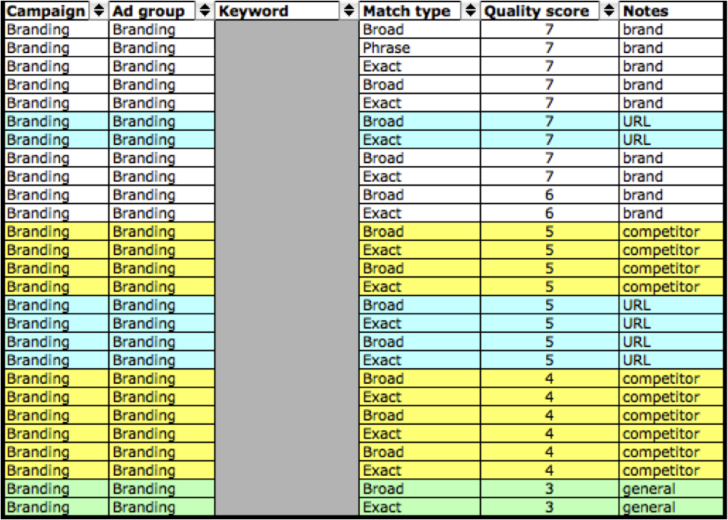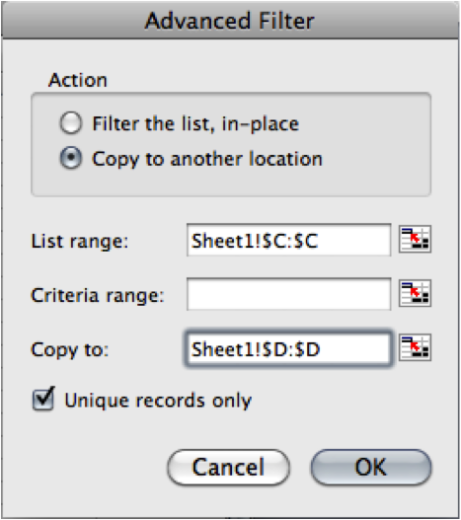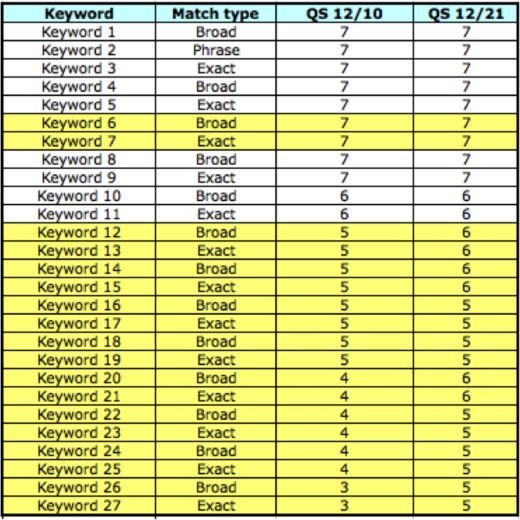Do you remember playing the game Telephone as a child? One person whispers a sentence into the ear of the person next to them, who whispers it to the person next to them and so on down the line, while trying to retain as much information of the message as possible. Inevitably, by the time the last person spoke the sentence aloud it barely resembled the original.
I felt like the person at the end of the telephone line when I first opened up a PPC account I was about to take over. It had been passed through the hands of many managers at different companies and by the time it reached me it was so jumbled and disorganized it was difficult to determine where to even begin optimizing. I decided to start analyzing the health of the account by taking a look at Quality Score.
On Monday, Robert posted about Account Level Quality Score and I wanted to estimate an account Quality Score of my own. Do determine this, I exported all active keywords into Excel and took the average of the Quality Scores to create my own account level Quality Score. It averaged out to a dismal 5.1. I then sorted my keywords into Google’s Quality Score categories:
This is when I began to realize how much help this account needed. Google considered less than half a percent of the keywords to be “Great.” Low Quality Score was an account-wide problem.
The next step was to decide where to start making changes in the account. I sorted my keyword data by campaign and used Excel’s subtotal function to get an average Quality Score for each. From this data, I chose to start my restructure with the Branding campaign as it had one of the lowest average Quality Scores. I began drilling down using best practices from our Quality Score Handbook to evaluate the campaign’s keywords, ad text, and landing pages.
KEYWORDS
Best Practice: Create Tightly Themed Ad Groups.
The first thing I noticed when I opened up the Branding campaign was that it contained only one ad group, not necessarily a bad sign as long as all the keywords are closely related. This ad group though contained twenty-seven keywords with Quality Scores ranging from 3 to 7. Obviously some words were better suited for this ad group than others.
I went through the keyword list and made a note next to each whether it was related to the branding of the company or not. If not, I noted what category the keyword did fall into. (Keywords covered for client privacy.)
The ad group included names of competitors as well as general industry terms. The account already has a Competitors and General Terms campaign, so new ad groups were created for these keywords. I also separated out URLs for the company, as there were enough terms to create a new ad group within the Branding campaign.
Best Practice: Take Advantage of all Match Types
The match type of a keyword does not directly affect a keyword’s Quality Score. AdWords only collects data when a user’s search query matches exactly to a keyword and the Quality Score of the exact match is then shared with the broad and phrase match versions. So why bother with different match types? If you include all three match types for a keyword you can see which one gives you a better ROI. Bidding higher on match types that receive more clicks reducing bids on others will improve your CTR, a main factor of Quality Score.
In the Branding campaign almost all of the keywords were either broad or exact match. I’m not sure whether it was like this from the beginning or if it was a conscious decision made along the way, but since I don’t know the reason behind it I included all three match types for the keywords in all the ad groups I created. As time goes on I will focus more of our limited budget on the keyword match types that are driving the most traffic to the site.
AD TEXT
Best Practice: Put Keywords in Ad Copy
Including keywords in the ad copy was a practice already put in place in the account. The current Branding campaign had three ads running all with one or two keywords in the copy. The only task here was to create ads for the new ad groups. To determine which headlines and ad descriptions worked best historically I ran an ad report for all time and sorted by CTR. I then pulled phrases from the best performing ads and inserted the keywords. This way I am using ads that have proven successful to bring in more clicks and improve Quality Score.
LANDING PAGES
Best Practice: Link to Quality, Relevant Landing Pages.
What makes improving Quality Score difficult for this account is that we have no control over the content on the landing pages. The website is controlled by another company and we can only choose which page to link with our ads. Because of this, I decided to do what I like to call a landing page review. First, I wanted to get a list of the different landing pages the ads were going to. To do this, I ran a Destination URL report and downloaded it to Excel. To create a list with each unique landing page I set an advanced filter for the Destination URL column.
Data >> Filter >> Advanced Filter:
In the Advanced Filter box you can choose to either filter the list in the current column or copy to another location. I like to copy it so I maintain the original data file. The list range is your destination URL column and then select “Unique record only.” This will give you one list of the different landing pages your ads are currently going to. You might want to do this every once in awhile for general maintenance as well. I found one URL which was misspelled and taking users to a site not at all related to the client.
Next, I went to each landing page and read through the text on the page, recording the keywords as I went. What I ended up with was a spreadsheet with a column for each landing page and its keywords structured like this:
It can be time consuming especially if you have many landing pages, but organizing the keywords made it much easier for me to pick the most relevant landing page for my new ads.
EVALUATION
The newly structured campaign and ad groups have been running undisturbed for about a week. I went back into the account today to compare the current Quality Score to the Quality Score before the restructure. (Keywords in yellow were moved from the original ad group.)
Though no keywords managed to break into the Great 8-10 range, all the keywords did move up from Poor to OK. I am confident that with more time and more optimization Quality Score will only continue to improve.
If you have any questions about improving Quality Score or tips that have worked for you please post them below!








